| |
| Introduction | Checklist | Key to genera | Species keys | Gallery | References | PDF 41.7 MB | Cite this Article | Updates |
The Bee Flies (Diptera: Bombyliidae) of Ontario, with a Key to the Species of Eastern Canada
CJAI 06 March 06, 2008
doi: 10.3752/cjai.2008.06
Joel H. Kits* , Stephen A. Marshall* , and Neal L. Evenhuis**
* Department of Environmental Biology, University of Guelph, 50 Stone
Rd. E., Guelph, Ontario N1G 2W1, Canada jkits@uoguelph.ca, samarsha@uoguelph.ca
** Department of Natural Sciences, Bishop Museum, 1525 Bernice Street,
Honolulu, Hawaii 96817, USA neale@bishopmuseum.org
3. Key to the Bombylius species of Ontario and eastern Canada
Larval hosts are solitary bees. Adults are mostly active in spring and early summer, with occasional later records. Key based in part on Hall and Evenhuis (1980).
| 1. |
Wing with dark spots or transverse bands (Figure 61c,d) |
2 |
| - |
Wings clear to extensively brown at base, not spotted (Figure 61e-m) |
3 |
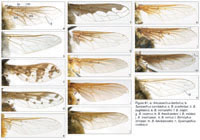
| 2. |
Wing spots connected in bands across wing (Figure 61c), pile yellow and black (Figure 25a) |
pulchellus |
| |
5-7 mm. South-central Ontario, north to Washago (southern Canada and northeastern U.S., west to Kansas). Adults fly May – mid June. |
|
| - |
Wing spots not connected into bands (Figure 61d), pile reddish brown and white (Figure 25a) |
pygmaeus |
| |
6-10 mm. Widespread in Ontario, but apparently absent from the southwest (Alaska, Canada, northeastern U.S. south to Georgia; also China). Adults fly May – mid June. |
|
 
| 3. |
Wings almost entirely clear, slightly darkened at base. Crossvein r‑m situated near basal ¼–⅓ of cell dm (Figure 61e). Body pile golden yellow, no black pile present (Figure 26) |
comanche |
| |
6-8 mm. Rarely collected in Ontario, recorded from Windsor north to Simcoe Co. (Great Lakes area and central U.S. to the Rockies). Adults recorded from late June to early August, mostly in first half of July. |
|
| - |
Wings extensively darkened at base. Crossvein r‑m at or beyond basal ⅓ of cell dm (Figure 61f-m). Body pile various colours but never entirely yellow. |
4 |
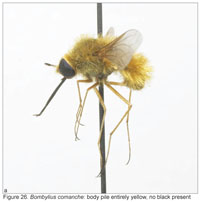 
| 4. |
Dark anterior and clear posterior portions of wing sharply demarcated (Figure 61f) |
major |
| |
7-13 mm. Widespread in Ontario north to Sioux Lookout (widespread Holarctic including China and Japan; also Oriental region [India, Nepal, Bangladesh, and Thialand]). Adults fly late April – early June. |
|
| - |
Dark portion of wing blending into clear portion (Figure 61g-m) |
5 |

| 5. |
Pile on face and cheeks white, body pile predominately white, with black and brown pile scattered on mesonotum and margins of abdominal tergites (Figure 27a) |
incanus* |
| |
8-10 mm. Not recorded from Ontario (eastern U.S. seaboard, Maine south to Georgia). |
|
| - |
Pile on face black (Figure 27b); body pile of various colours, but predominately yellow dorsally |
6 |
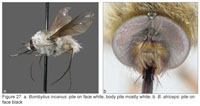
| 6. |
Wing entirely smoky brown, darker at base (Figure 61h,i) |
7 |
| - |
Smoky brown colour restricted to base of wing, posterior portion clear or grayish (Figure 61j-m) |
8 |

| 7. |
Long black pile on posterior margins of abdominal tergites (Figure 28a), coxae and abdominal sternites with pale yellow to white pile (Figure 29a), humeral and postalar callus usually black (Figure 30a) |
fraudulentus |
| |
7-8 mm. Rare in Ontario, collected from Pinery Provincial Park and Norfolk Co. (also northeastern U.S. from Massachusetts south to Georgia). Adults recorded in July. |
|
| - |
Abdominal tergites covered in yellow pile (Figure 28b), coxae and abdominal sternites with black pile (Figure 29b), humeral and postalar callus red (Figure 30b) |
validus* |
| |
12-13 mm. Not recorded from Ontario (rarely collected in the northeastern United States). |
|
  
| 8. |
Large species (10-13 mm), female with stripe of whitish tomentum along center of abdominal tergites 2-5 (Figure 31a) |
9 |
| - |
Medium-sized species (8-9 mm), female with extensive yellow tomentum on abdomen, without a central stripe of white on tergites 2-5 (Figure 31b) |
10 |

| 9. |
Postalar callus red (Figure 32a), abdomen with prominent bands of black pile on segments 2 and 3, posterior segments with white pile laterally and black pile medially (Figure 32c) |
varius* |
| |
11-13 mm. Not recorded from Ontario(eastern U.S. from Ohio east to Maine and south to Florida). |
|
| - |
Postalar callus black (Figure 32b), abdomen with a few black hairs along posterior edges of segments (Figure 32d), otherwise covered with yellow pile |
mexicanus |
| |
10-12 mm. South-central to central Ontario (widespread in eastern and southern U.S.).Adults fly late May – early July. |
|
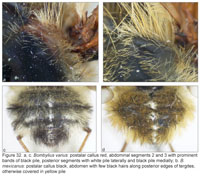
| 10. |
Face yellowish to reddish brown (Figure 33a). Brown part of wing extending to near tip of R1 (Figure 61l). Both sexes with white pile on all coxae (Figure 34a) |
atriceps |
| |
9 mm. Rare in Ontario, known only from Constance Lake and “Severn” [=Severn Bridge?] (widespread, southern Canada and northeastern and midwestern U.S.) Adults recorded in late June. |
|
| - |
Face dark brown to black (Figure 33b). Brown part of wing extending to near tip of R2+3 (Figure 61m). Male with black pile on coxae (Figure 34c), female with white pile on fore coxa, mixed black and white pile on middle and hind coxae (Figure 34b) |
fulvibasoides* |
| |
8 mm. Not recorded from Ontario (widespread in northeastern and central U.S.). |
|
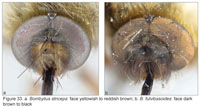  
Back to the generic key
| Introduction | Checklist | Key to genera | Species keys | Gallery | References | PDF 41.7 MB | Cite this Article | Updates |
|
|












